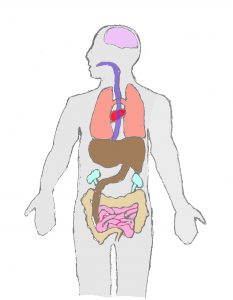
The human microbiome is a hot topic in the science realm, but it has also been making its way onto bestseller shelves at our bookstores. If you have been noticing this mysterious term more and more, perhaps you are wondering, just what are these microbes, and why do we need them?
The term microbiome refers to all of the microorganisms living in and on us, including bacteria, fungi, parasites, and viruses, and all of their genes. Our bodies are made up of trillions of cells, but in addition to our own cells, there are also trillions of microbial cells that inhabit every part of us they are in our eyelashes, ears, stomachs, mouths, and colons—they are everywhere. But what do they all do?
While many of us think of microbes as pathogenic or harmful, each one of us has our own unique set of “good” microbes, without which we could not survive. The microbes of our skin support our immune systems, and help us to ward off other “bad” microbes that cause disease. Microbes within our gut help us to digest certain foods, such as fiber, and they also nourish us with vitamins that our bodies are incapable of producing. These are just some of the reasons that we should care about the microbiome.
Research has suggested that disturbances within the microbiome—which can be caused by antibiotic overuse or poor dietary lifestyles—might contribute to modern diseases. Dr. Martin J. Blaser’s research has focused on Helicobacter pylori, a common bacteria found in our

stomachs, and its gradual decline in individuals of developed countries over the past 100 years. Humans have coevolved with H. pylori over the past 50,000 years, but it turns out this common gut bacteria is responsible for stomach ulcers, and gastric cancer. The fact that this microbe has been steadily declining may sound like a bonus, but Blaser suggests that low levels of H. pylori may have consequences, potentially leading to obesity, celiac disease, and asthma. Are humans losing an ancestral indigenous frenemy?
Viruses also play an important role. Dr. Ken Cadwell, a professor from the Department of Microbiology at New York University, uses mice to study how a virus can benefit the intestines, and even take over the job of friendly microbes that may be eliminated by antibiotics. While antibiotics are necessary for eradicating infectious microbes, they can also deplete the ones we need, and the sudden opening of gastrointestinal real estate makes mice susceptible to intestinal injury. Cadwell’s study shows that if a mouse treated with antibiotics is infected with Murine Norovirus, the virus steps in and restores its intestinal lining. This could this lead to the use of viral therapy as a treatment for gut maladies.
These are just a couple of examples from the swiftly growing body of knowledge regarding the microbiome. If it piques your curiosity, but you do not fancy reading scientific journal articles, try picking up Ed Yong’s I Contain Multitudes: The Microbes Within Us and a Grander View of Life, or Dr. Martin Blaser’s Missing Microbes: How the Overuse of Antibiotics Is Fueling Our Modern Plagues. They are wonderful reads for the non-scientist interested in how important our microbes are.






